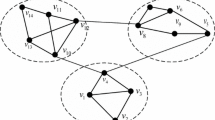Abstract
Community structure plays an essential role in analyzing networks. Various algorithms exist to find the community structure that scores high on a graph clustering index called Modularity. In divisive community structure algorithms, initially, all the nodes belong to a single community. Each iteration divides the nodes into two groups, and finally, each node belongs to a single community. The main disadvantage of a divisive algorithm is that it is not able to find whether to divide the community further or not. A divisive community detection algorithm is proposed based on the graph spectra that give the termination method for community detection. We rely on Weighted Spectral Distribution (WSD) to divide the network into small sub-network or not. Experiments with various real-world networks show that the proposed method constantly compares favorably with the popular Girvan Newman’s community detection algorithm.
Access this chapter
Tax calculation will be finalised at checkout
Purchases are for personal use only
Similar content being viewed by others
Change history
11 February 2023
A correction has been published.
References
Courtain, S., Leleux, P., Kivimäki, I., Guex, G., Saerens, M.: Randomized shortest paths with net flows and capacity constraints. Inf. Sci. 556, 341–360 (2021)
Chakraborty, D., Singh, A., Cherifi, H.: Immunization strategies based on the overlapping nodes in networks with community structure. In: Nguyen, H.T.T., Snasel, V. (eds.) CSoNet 2016. LNCS, vol. 9795, pp. 62–73. Springer, Cham (2016). https://doi.org/10.1007/978-3-319-42345-6_6
Kumar, M., Singh, A., Cherifi, H.: An efficient immunization strategy using overlapping nodes and its neighborhoods. In: 2018 Companion Proceedings of the The Web Conference, pp. 1269–1275 (2018)
Ibnoulouafi, A., El Haziti, M., Cherifi, H.: M-centrality: identifying key nodes based on global position and local degree variation. J. Stat. Mech: Theory Exp. 2018(7), 073407 (2018)
Rajeh, S., Savonnet, M., Leclercq, E., Cherifi, H.: Interplay between hierarchy and centrality in complex networks. IEEE Access 8, 129717–129742 (2020)
Orman, G.K., Labatut, V., Cherifi, H.: Towards realistic artificial benchmark for community detection algorithms evaluation. arXiv preprint arXiv:1308.0577 (2013)
Barnes, E.R.: An algorithm for partitioning the nodes of a graph. SIAM J. Algebraic Discrete Methods 3(4), 541–550 (1982)
Shi, J., Malik, J.: Normalized cuts and image segmentation. Departmental Papers (CIS), p. 107 (2000)
Friedman, J., Hastie, T., Tibshirani, R.: The Elements of Statistical Learning. Springer Series in Statistics, vol. 1. Springer, New York (2001)
Wagstaff, K., Cardie, C., Rogers, S., Schrödl, S., et al.: Constrained k-means clustering with background knowledge. In: ICML, vol. 1, pp. 577–584 (2001)
Ng, A.Y., Jordan, M.I., Weiss, Y.: On spectral clustering: analysis and an algorithm. In: Advances in Neural Information Processing Systems, pp. 849–856 (2002)
Newman, M.E.J.: Fast algorithm for detecting community structure in networks. Phys. Rev. E 69(6), 066133 (2004)
Fay, D., et al.: Weighted spectral distribution for internet topology analysis: theory and applications. IEEE/ACM Trans. Netw. (ToN) 18(1), 164–176 (2010)
Acknowledgements
This work is supported by Science and Engineering Research Board (SERB), DST, Government of India under MATRICS project (Fill No. MTR/2019/000631).
Author information
Authors and Affiliations
Corresponding author
Editor information
Editors and Affiliations
Rights and permissions
Copyright information
© 2023 The Author(s), under exclusive license to Springer Nature Switzerland AG
About this paper
Cite this paper
Vashishtha, R., Singh, A., Cherifi, H. (2023). A Community Detection Algorithm Using Random Walk. In: Dinh, T.N., Li, M. (eds) Computational Data and Social Networks . CSoNet 2022. Lecture Notes in Computer Science, vol 13831. Springer, Cham. https://doi.org/10.1007/978-3-031-26303-3_20
Download citation
DOI: https://doi.org/10.1007/978-3-031-26303-3_20
Published:
Publisher Name: Springer, Cham
Print ISBN: 978-3-031-26302-6
Online ISBN: 978-3-031-26303-3
eBook Packages: Computer ScienceComputer Science (R0)




